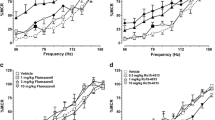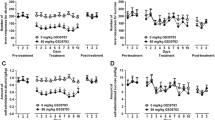Abstract
Rationale
Previously, we reported that the GABAA receptor containing α5 subunit played a significant role in the reinforcing actions of EtOH in rats selectively bred to consume alcohol. However, the role of the α5 receptor in regulating the neurobehavioral effects of EtOH in outbred rats is not known.
Objective
In the present study, RY024, a novel benzodiazepine (BDZ) inverse agonist with high affinity (Kd~ 0.40 nM) and selectivity (~67.3-fold) for the α5 receptor, was investigated for its capacity to antagonize EtOH’s reinforcing, motor impairing, and sedative effects in Long-Evans rats.
Methods
Rats were trained to lever press for EtOH under a fixed-ratio 1 schedule of reinforcement. Subsequent studies evaluated EtOH’s motor-impairing effects in an oscillating bar task, while EtOH’s sedative effects were measured in the open field.
Results
RY024 (0.125−3.5 mg/kg; IP) markedly reduced EtOH-maintained responding with no effects on water responding, except for the highest dose. RY024 (3.0−15 mg/kg; IP) also reversed the motor impairing effects of a moderate (0.75 g/kg), and intoxicating EtOH dose (1.25 g/kg) in the absence of intrinsic effects. Finally, RY024 (7.5 mg/kg) attenuated the sedation produced by the 1.25 g/kg EtOH dose; however, it failed to attenuate the sedation induced by the 0.75 g/kg EtOH dose. Given alone, RY024 exhibited intrinsic effects in the open field.
Conclusion
The results suggest the GABAA receptor containing α5 subtype plays an important role in regulating the reinforcing, motor-impairing, and sedative effects of alcohol in outbred rats.



Similar content being viewed by others
References
Barnard EA, Skolnick P, Olsen RW, Möhler W, Sieghart W, Biggio G, Braestrup C, Bateson AN, Langer SZ (1998) International union of pharmacology. XV. Subtypes of γ-aminobutyric acid receptors: classification on the basic of subunit structure and receptor function. Pharmacol Rev 50:291–313
Bell R L, Stewart R B, Woods II J E, Lumeng L, Li T K, Murphy J M, McBride W J (2001) Responsivity and development of tolerance to the motor impairing effects of moderate doses of ethanol in alcohol-preferring (P) and –nonpreferring (NP) rat lines. Alcohol Clin Exp Res 25:644–650
Dar MS (1992) Selective antagonism of acute ethanol-induced motor disturbances by centrally administered Ro15-4513 in mice. Pharmacol Biochem Behav 42:473–479
Draski LJ, Deitrich RA (1996) Initial effects of ethanol on the central nervous system. In: Deitrich RA, Erwin VG (eds) Pharmacological effects of ethanol on the nervous system. CRC Press, Boca Raton, pp 244–277
Jackson HC, Nutt DJ (1995) Inverse agonists and alcohol. In: Sarter M, Nutt DJ, Lister RG (eds) Benzodiazepine receptor inverse agonists. Wiley-Liss, New York, pp 113–118
June HL (2002) Preclinical models to evaluate potential pharmacotherapeutic agents in treating alcoholism and studying the neuropharmacological bases of ethanol-seeking behaviors in rats. In: Crawley J, Gerfen C, Mc Kay R, Rogawski M, Sibley D, Skolnick P (eds) Current protocols in neuroscience. Wiley, New York, pp 1–23
June HL, Lin M, Greene TL, Lewis MJ, Murphy JM (1995a) Effects of negative modulators of GABAergic efficacy on ethanol intake: correlation of biochemical changes with pharmacological effect using a behavioral paradigm. J Exp Clin Psychopharmacol 3:252–258
June HL, Duemler S, Greene TL,Williams J, Lin M, Chen SHA, Lewis MJ, Murphy JM (1995b) Effects of RO19-4603 on the maintenance of tolerance to a single dose of ethanol. J Pharmacol Exp Ther 247:1105–1112
June HL, Torres L, Cason CR, Hwang BH, Braun MR, Murphy JM (1998a) The novel benzodiazepine inverse agonist RO19-4603 antagonizes ethanol motivated behaviors: neuropharmacological studies. Brain Res 784: 256–275
June HL, Zucarelli D, Craig KS, DeLong J, Cason CR, Torres L, Murphy JM (1998b) High affinity benzodiazepine antagonists reduce responding maintained by EtOH presentation in ethanol-preferring (p) rats. J Pharmacol Exp Ther 284:1006–1014
June HL, Eggers MW, Warren-Reese C, Ricks A, Cason CR (1998c) The effects of the novel benzodiazepine receptor inverse agonist Ru34000 on ethanol-maintained responding. Eur J Pharmacol 350:151–158
June H L, Cason C R, Cheatham G, Ruiyan L, Gan T, Cook JM (1998d) GABAA-benzodiazepine receptors in the striatum are involved in the sedation produced by a moderate, but not an intoxicating ethanol dose in outbred Wistar rats. Brain Res 794:103–118
June HL, Dejaravu SL, Williams J, Cason CR, Eggers MW, Greene TL, Leviege T, Torres LB, Murphy JM (1998e) GABAergic modulation of the behavioral actions of in alcohol-preferring (P) and nonpreferring (NP) rats. Eur J Pharmacol 42:139–151
June HL, Harvey SC, Foster KL, McKay PF, Cummings R, Garcia M, Mason D, Grey C, McCane SL, Williams L, Durr LF, Johnson TB, Xiaohui H, Rock S, Cook JM (2001) GABAA-receptors containing α5 subunits in the CA1 and CA3 hippocampal fields regulate ethanol-motivated behaviors: an extended ethanol reward circuitry. J Neurosci 21:2166–2177
Koob GF, Braestrup C, Britton KT (1986) The effects of Ro15-4513 on the release of punished responding produced by chlordiazepoxide and ethanol in the rat. Psychopharmacology 90:173–178
Korpi ER, Kleingoor C, Ketterman H, Seeburg PH (1993) Benzodiazepine-induced motor impairment linked to point mutation in cerebellar GABAA receptor. Nature 361:356
Lê AD, Israel Y (1994) A simple technique for quantifying intoxication-induced by low doses of ethanol. Pharmacol Biochem Behav 48:229–234
Lewis MJ, June HL (1990) Neurobehavioral studies of ethanol reward and activation. Alcohol 7:213–219
Liljequist S, Engel J (1982) Effects of GABAergic agonists and antagonists on various ethanol-induced behavioral changes. Psychopharmacology 64:61–65
Lui RY, Zhang PW, McKernan R, Wafford K, Cook J M (1995) Synthesis of a novel imidazobenzodiazepine ligands for the α5β2γ2 Bz5 GABAA receptor subtype. Med Chem Res 5:700–709
Lui RY, Hu RJ, Zhang PW, Skolnick P, Cook J M (1996) Synthesis and pharmacological properties of novel 8-substituted imidazobenzodiazepines: high affinity, selective probes for α5 containing GABAA receptors. J Med Chem 39:1928–1934
McBride WJ, Li TK (1998) Animals models of alcoholism: neurobiology of high alcohol-drinking behavior in rodents. Crit Rev Neurobiol 12:339–369
Meng Z, Dar MS (1994) Intrastriatal Ro15-4513 functionally antagonizes ethanol-induced motor incoordination and striatal adenosinergic modulation of ethanol-induced motor incoordination in rats. J Pharmacol Exp Ther 271:524–534
Nutt DJ, Lister RG (1989) Antagonizing the anticonvulsant effects of ethanol using drugs acting at the benzodiazepine/GABA receptor complex. Pharmacol Biochem Behav 31:751–755
Rudolf U, Crestani F, Benke D, Brünig I, Benson JA, Fritschy JM, Martin JR, Bluethmann H, Mohler H (1999) Benzodiazepine actions mediated by specific γ-aminobutyric acidA receptor subtypes. Nature 401:796–800
Sanger DJ, Cohen C (1995) Fear and anxiety induced by inverse agonists. In: Sarter M, Nutt DJ, Lister RG (eds) Benzodiazepine receptor inverse agonists. Wiley, New York, pp 185–213
Skolnick P, Schweri M, Williams E, Moncada V, Paul S (1982) An in vitro test which differentiates benzodiazepines “ agonist” and “antagonist”. Eur J Pharmacol 78:133–136
Skolnick P, Hu R J, Cook CM, Hurt S D, Trometer JD, Lui R, Huang Q, Cook JM (1997) RY80: A high affinity, selective ligand for γ-aminobutyric acidA receptors containing alpha-5 subunits. J Pharmacol Exp Ther 283:488–493
Suzdak P, Glowa JR, Crawley JN, Schwartz RD, Skolnick P, Paul SM (1986) A selective imidazodiazepine antagonist of ethanol in the rat. Science 234:1243–1247
Turner D, M Sapp, DW, Olsen RW (1991) The benzodiazepine/alcohol antagonist RO15-4513: binding to a GABAA receptor subtype that is insensitive to diazepam. J Pharmacol Exp Ther 257:1236–1242
Wafford KA, Bain CJ, Whiting PJ, Kemp JA (1993) Functional comparison of the role of γ subunits in recombinant human γ-aminobutyric acidA/benzodiazepine receptors. Mol Pharmacol 44:437–442
Wisden H, Laurie DJ, Monyer H, Seeburg PH (1992) The distribution of 13 GABAA receptor subunit mRNAs in the rat brain: telencephalon, diencephalon, mesencephalon. J Neurosci 12:1040–1062
Wong et al. (1993)
Acknowledgements
This research was supported in part by grants AA10406, AA11555, and AA12407 (H.L.J.) from the National Institute of Alcohol Abuse and Alcoholism (NIAAA) and MH 46851 (J.M.C.) from the National Institute of Mental Health (NIH). Pete McKay was supported in part by a UROP stipend from the School of Science at IUPUI. Katrina Foster and Marin Garcia were supported in part by grant T35 M from the National Heart Lung and Blood Institute of the NIH (Short Term Training Program for Minority Students in Biomedical Research). Katrina Foster was also supported in part by a Minority Neuroscience Fellowship from the American Psychological Association and the Alcohol Research Center Training Grant from NIAAA (AA07462).
Author information
Authors and Affiliations
Corresponding author
Rights and permissions
About this article
Cite this article
McKay, P.F., Foster, K.L., Mason, D. et al. A high affinity ligand for GABAA-receptor containing α5 subunit antagonizes ethanol’s neurobehavioral effects in Long-Evans rats. Psychopharmacology 172, 455–462 (2004). https://doi.org/10.1007/s00213-003-1671-z
Received:
Accepted:
Published:
Issue Date:
DOI: https://doi.org/10.1007/s00213-003-1671-z




